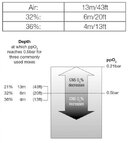Hi Rgiggi127,
Because of the limited duration and intermittent exposure, pulmonary oxygen toxicity is not a practical problem in most diving.
On the other hand, CNS oxygen toxicity may result in seizure and almost certain drowning. CNS oxygen toxicity can be acute and unpredictable, generally with exposures in excess of 1.4 bar, or can be related to more prolonged exposure. It is the latter that is tracked by the CNS clock and these values are generally taken from the NOAA oxygen exposure table included below. Most dive computers, and your Luna, alert you to either type of potentially dangerous exposure by telling you when you have exceeded the maximum operating depth for your gas (this can often be set anywhere in the range of 1.2-1.6 bar) or when you are approaching or have exceeded 100% of your CNS clock.
Some dive computers (like my Oceanic) track CNS oxygen exposure on a rolling 24 hour basis and this is how the NOAA table was designed to be used. Other computers (like your SP Luna) include an oxygen elimination half life when oxygen exposure is low, below 0.5 bar with the Luna. The oxygen elimination half life for the Luna is not stated in the owner's manual,
it would be interesting to hear from Scubapro what value is used. The half life is most commonly said to be 90 minutes. I was interested in this topic and posted here on SB. It turns out that the topic is somewhat controversial and there is no consensus
http://www.scubaboard.com/forums/advanced-scuba-discussions/471123-cns-o2-exposure.html
Hope this helps, good diving, Craig
[TABLE="width: 144"]
[TR]
[TD="class: xl69, width: 192, bgcolor: transparent, colspan: 3"]
O2 Exposure (h)
[/TD]
[/TR]
[TR]
[TD="class: xl64, bgcolor: transparent"]
pO2
[/TD]
[TD="class: xl65, bgcolor: transparent"]
Single
[/TD]
[TD="class: xl66, bgcolor: transparent"]
24 hours
[/TD]
[/TR]
[TR]
[TD="class: xl67, bgcolor: transparent"]
0.6
[/TD]
[TD="class: xl68, bgcolor: transparent"]
12
[/TD]
[TD="class: xl63, bgcolor: transparent"]
12
[/TD]
[/TR]
[TR]
[TD="class: xl67, bgcolor: transparent"]
0.7
[/TD]
[TD="class: xl68, bgcolor: transparent"]
9.5
[/TD]
[TD="class: xl63, bgcolor: transparent"]
9.5
[/TD]
[/TR]
[TR]
[TD="class: xl67, bgcolor: transparent"]
0.8
[/TD]
[TD="class: xl68, bgcolor: transparent"]
7.5
[/TD]
[TD="class: xl63, bgcolor: transparent"]
7.5
[/TD]
[/TR]
[TR]
[TD="class: xl67, bgcolor: transparent"]
0.9
[/TD]
[TD="class: xl68, bgcolor: transparent"]
6
[/TD]
[TD="class: xl63, bgcolor: transparent"]
6
[/TD]
[/TR]
[TR]
[TD="class: xl67, bgcolor: transparent"]
1
[/TD]
[TD="class: xl68, bgcolor: transparent"]
5
[/TD]
[TD="class: xl63, bgcolor: transparent"]
5
[/TD]
[/TR]
[TR]
[TD="class: xl67, bgcolor: transparent"]
1.1
[/TD]
[TD="class: xl68, bgcolor: transparent"]
4
[/TD]
[TD="class: xl63, bgcolor: transparent"]
4.5
[/TD]
[/TR]
[TR]
[TD="class: xl67, bgcolor: transparent"]
1.2
[/TD]
[TD="class: xl68, bgcolor: transparent"]
3.5
[/TD]
[TD="class: xl63, bgcolor: transparent"]
4
[/TD]
[/TR]
[TR]
[TD="class: xl67, bgcolor: transparent"]
1.3
[/TD]
[TD="class: xl68, bgcolor: transparent"]
3
[/TD]
[TD="class: xl63, bgcolor: transparent"]
3.5
[/TD]
[/TR]
[TR]
[TD="class: xl67, bgcolor: transparent"]
1.4
[/TD]
[TD="class: xl68, bgcolor: transparent"]
2.5
[/TD]
[TD="class: xl63, bgcolor: transparent"]
3
[/TD]
[/TR]
[TR]
[TD="class: xl67, bgcolor: transparent"]
1.5
[/TD]
[TD="class: xl68, bgcolor: transparent"]
2
[/TD]
[TD="class: xl63, bgcolor: transparent"]
3
[/TD]
[/TR]
[TR]
[TD="class: xl67, bgcolor: transparent"]
1.6
[/TD]
[TD="class: xl68, bgcolor: transparent"]
0.75
[/TD]
[TD="class: xl63, bgcolor: transparent"]
2
[/TD]
[/TR]
[/TABLE]




